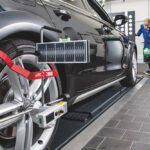Concrete Pumps Employed For Various Construction Projects
A concrete pump can be used for transferring liquid concrete by pumping. They are available in a number of sizes, but they are generally large, industrial machines utilized on construction sites to pour concrete in hard to access places that concrete mixers can’t achieve, for example around the tops of structures. They are made to feed concrete to those areas from the good distance as rapidly and effectively as you possibly can.
You will find typically two kinds of pumps a boom concrete pump along with a line pump. Boom pumps are large machines having a boom arm store the period of rubberized tubing by which the cement flows where needed around the construction site. Boom concrete pumps can pump concrete in a vertical achieve as high as 65 meters along with a horizontal achieve close to 300 meters. The size of the boom determines what lengths away the18 wheeler is going to be placed where the concrete will be pumped. This will make them particularly helpful for flowing concrete in multi-floor structures along with other high-rise construction jobs.
A trailer-mounted boom concrete pump uses an articulating arm, or placing boom to pour concrete wherever it’s needed. The Chimera Trailer Boom Pump includes a 14m 3-section fold boom, which, if additional pipeline is added, can pump concrete in a vertical achieve of 65m along with a horizontal achieve of 300m at rates of 46m3 each hour. These boom pumps provide a good value option to traditional truck-mounted pumps, for pricey to operate and may encounter problems on jobs where you can find access or weight limitations. Boom pumps are utilized on the majority of the bigger construction projects, because they are able to pumping at high volumes and due to the work saving nature from the placing boom. They’re an innovative option to truck-mounted concrete pumps.
Truck-mounted concrete pumps can be found in an array of sizes with boom lengths varying from 21- 66 metres and concrete outputs as high as 185m3/hour at pressures as high as 80 bars. They’ve whether 3, four to five section placing boom with a choice of ‘z’ fold, ‘roll’ fold or ‘multi-z’ fold opening, which makes them simple to manoeuvre and suitable for all kinds of concrete placing work, even where space is fixed. Telescopic booms can be included to concrete pumps to achieve probably the most isolated spaces. Most pumps around the bigger concrete pump trucks are run by the truck’s engine inside a power-takeoff (PTO) configuration. Some pumps, however, especially on smaller sized concrete pump trucks, are powered using their own engine. Diesel engines can be used for this kind of heavy-duty work due to their economical, yet effective mechanical dynamics.
Concrete line pumps can be used for smaller sized construction projects than boom pumps. They’re versatile, portable units accustomed to pump not just structural concrete, but additionally grout, wet screeds, mortar, foamed concrete, and sludge. Line pumps typically make use of a ball-valve-type pumping system. They are utilised for structural concrete and shotcreting (concrete placed using a ruthless hose and compacted simultaneously) where low-volume output is appropriate. Some hydraulically driven models can pump structural concrete at outputs exceeding 137 m3 each hour.
Line pumps normally pump concrete at lower volumes than boom pumps and can be used for smaller sized volume concrete placing projects for example pools, sidewalks, and single home concrete slabs and ground slabs.
The construction industry has undergone sea changes in the past few decades. The work that was earlier done manually is now done with the help of machines. A concrete pump is one such equipment that is used to pump liquid concrete.




